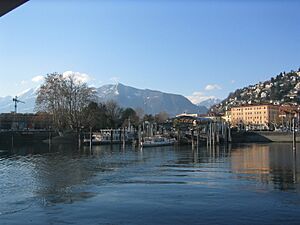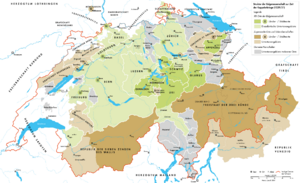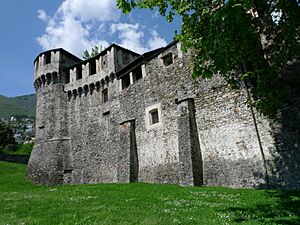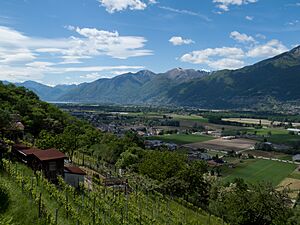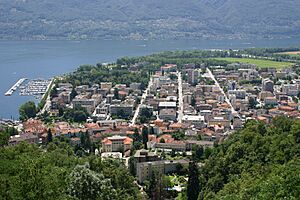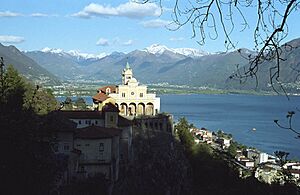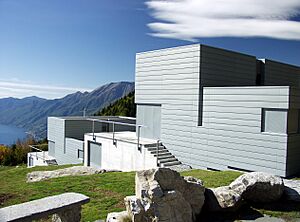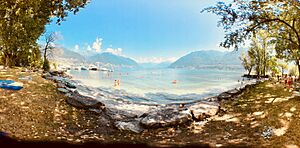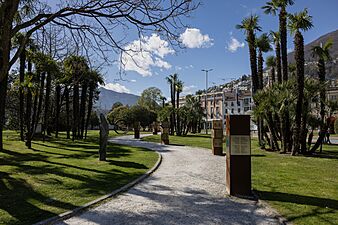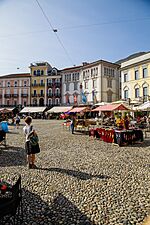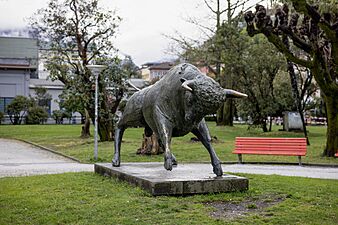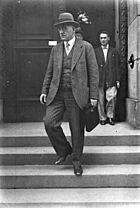Locarno facts for kids
Quick facts for kids
Locarno
|
||
|---|---|---|
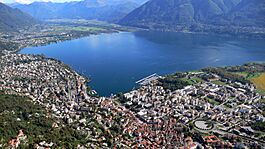 |
||
|
||
| Country | Switzerland | |
| Canton | Ticino | |
| District | Locarno | |
| Area | ||
| • Total | 18.69 km2 (7.22 sq mi) | |
| Elevation | 200 m (700 ft) | |
| Population
(Dec 2020 )
|
||
| • Total | 15,728 | |
| • Density | 841.52/km2 (2,179.5/sq mi) | |
| Demonym(s) | Italian: Locarnesi | |
| Postal code |
6600
|
|
| Localities | Solduno, Monte della Trinità, Brè sopra Locarno, Ponte Brolla, Riazzino (Piano di Magadino), Gerra Piano (Piano di Magadino) | |
| Surrounded by | Ascona, Avegno, Cadenazzo, Cugnasco, Gerra (Verzasca), Gambarogno, Gordola, Lavertezzo, Losone, Minusio, Muralto, Orselina, Tegna, Tenero-Contra | |
| Twin towns |
|
|
Locarno is a beautiful town in southern Switzerland. It sits on the northern shore of Lake Maggiore in the canton of Ticino, right at the foot of the Swiss Alps. About 16,000 people live in Locarno itself, but if you include nearby towns like Ascona, the total population is around 56,000.
Locarno is located on the northeastern side of the Maggia river's delta. Across the river, you'll find the town of Ascona. Locarno is the third largest city in the Ticino canton, after Lugano and Bellinzona.
The main language spoken in Locarno is Italian.
The town is famous for two big things:
- The Locarno International Film Festival, which happens every August. Movies are shown outdoors in the main square, called Piazza Grande.
- The Locarno Treaties, which were important agreements about European borders made here in October 1925.
Contents
- History of Locarno
- Geography of Locarno
- Locarno's Coat of Arms
- People of Locarno
- Historical Population Changes
- Important Heritage Sites
- Main Attractions in Locarno
- Locarno's Economy
- Religion in Locarno
- Education in Locarno
- Transportation
- Sports
- Images for kids
- Notable People from Locarno
- International Connections
- See also
History of Locarno
Ancient Times
People have lived in the Locarno area for a very long time! In 1934, archaeologists found an ancient burial ground with 14 urn graves from the Early Bronze Age (around 1400 BC). These urns held burned bones and bronze jewelry like bracelets and hairpins. Similar finds were made in another area called S. Antonio.
Later, in 1935, a much larger burial ground was found at Solduno. This one had over 200 graves and was used for almost a thousand years, from the La Tène culture (around 450 BC) to the 3rd century AD. Many items found here, especially from the Celtic period, showed influences from areas north of the Alps.
Roman Era
Between 1946 and 1949, more Roman era tombs were found. This tells us that the Roman town of Locarno was located between the area of Muralto and this cemetery. Unfortunately, a lot of the old Roman city was destroyed by building and farming over the years. In 1995 and 1997, 57 more graves were found, confirming that both cremation (burning bodies) and burial were practiced. Many glass items were also discovered. The Roman influence was very strong, changing much of the local culture.
Noble Families of Locarno
The capitanei were important noble families who led Locarno in the early Middle Ages. The first mention of this title was in 1164, when Emperor Frederick I gave the town the right to hold markets. These families were like direct helpers of the king. They managed church property and had some power, but they couldn't make big legal decisions.
These families played a key role in the conflicts between the Guelphs and Ghibellines in the 13th and 14th centuries. During the Reformation in the 16th century, two of the main families, the Muralto and Orelli families, left Locarno and moved to Zürich. The third big family, the Magoria, stayed. The capitanei remained important in Locarno's politics until 1798. Later, in 1803, their lands and rights became part of the official town of Locarno.
Early Development of Locarno
Locarno was first mentioned in 807 as Leocarni. It was likely a market town near the lake even in Roman times. Its location helped it become an important place. For a long time, Locarno and Ascona worked together as a community, sharing common resources like pastures and forests.
In the 10th century, the Bishop of Milan tried to gain more power. But Henry II brought Locarno under the Diocese of Como in 1002/04. Friedrich Barbarossa gave Locarno special market rights in 1164, which helped the town become more independent. The ordinary citizens (borghesi) gained more rights, and by 1224, they had their own government and special privileges.
Locarno was the main administrative center for the area. In 1342, the Visconti family from Milan took control of Locarno. In 1439, Count Franchino Rusca was given Locarno as a fief (a piece of land given in exchange for loyalty).
Under Swiss Rule
The Rusca family's rule ended in 1503 when the Swiss Confederates took over Locarno. After a battle in 1513, the French King Louis XII gave the Confederates the castle. By 1516, they had full control of Locarno. The Swiss cantons took turns appointing a governor to rule the town. This governor had legal power, but also had to follow Locarno's local laws.
Under Swiss rule, society in Locarno was divided into three main groups: the nobles, the citizens (borghesi), and the long-term residents who weren't citizens (terrieri). Each group had its own property and governing body. All three groups had representatives in the Consiglio Magnifico, which governed Locarno.
Locarno's town center was busy with large houses, courtyards, and gardens. Wealthy families also owned country houses with vineyards.
Locarno's Castles
Locarno had several castles in the Early Middle Ages. One important castle, first mentioned in 1210, was taken over by the Visconti family in 1342 and made bigger. This became known as Visconti Castle. In 1531, the Swiss Confederates destroyed much of it, leaving only the main part.
The castle was used by the governor, but it started to fall apart over time. From 1804 to 1909, it housed government offices and the District Court. After 1909, the city bought it and renovated it. Since 1920, it has been home to the city and Archaeological Museum. It's even thought that Leonardo da Vinci might have designed a part of the castle's defenses in 1507!
Early Modern Locarno Life
In the Middle Ages, Locarno's economy was tied to the nobles who controlled markets, fishing, and farming rights. Later, citizens gained some of these rights. Viticulture (grape growing) was important in the hills, while grain was grown in the plains. The town also had artisans and shops.
Locarno became a busy trading hub, connecting major cities in Lombardy (Italy) with German-speaking Switzerland and Germany. Goods like grain and salt came from Italy, while Locarno sent wood and cattle back.
Many churches were important to Locarno. The main church, S. Antonio Abate, was built in 1353–54 and rebuilt in 1664. Its decorations were paid for by grain traders. The church of San Francesco, built in the early 13th century, was also very important. It hosted meetings of nobles and citizens.
In the 16th century, a religious order called the Humiliati was closed down. Their church and monastery became the Hospital S. Carlo, which helped people until 1854.
Locarno's population decreased in the 16th century due to people leaving because of religious changes and the plague in 1576–77. It recovered in the 17th century but declined again in the 18th century.
The Protestant Reformation
By 1535, there was a Protestant community in Locarno. This was due to the efforts of Giovanni Beccaria and others. In 1554, Protestants were given an ultimatum: change their faith or leave. On March 3, 1555, over 100 people left Locarno and moved to Zürich.
During the Counter-Reformation in the 17th century, many religious buildings in Locarno were renovated or rebuilt, including the church of SS Sebastiano e Rocco and the church of S. Maria Assunta.
Locarno in the Canton of Ticino
Under the Helvetic Republic (1798–1803), Locarno was part of the Canton of Lugano. In 1803, the Act of Mediation created the Canton of Ticino, and Locarno became an independent town. The old system of three different groups (nobles, citizens, and terrieri) ruling the town slowly faded away.
The Constitution of 1814 made Locarno, Bellinzona, and Lugano the capital cities of the canton, rotating every six years. Locarno was the capital several times. The town saw some political unrest, with uprisings in 1839 and 1841.
In the 19th century, Locarno's population grew, but not as fast as some other towns that benefited from the Gotthard railway.
The main church, S. Antonio Abate, was damaged in 1863 when its roof collapsed, killing 40 people. The town took over its ownership and maintenance. The church of San Francesco was also used for various purposes, including government offices and even a barracks, before becoming a church again.
Modern Locarno
From 1935 to 1992, a newspaper called L'Eco di Locarno was printed here. It later merged with another paper to become La Regione. Since 1987, the only German-language newspaper in Ticino, the Tessiner Zeitung, is published in Locarno three times a week.
Geography of Locarno
Locarno covers an area of about 19.27 square kilometers (7.44 sq mi).
- About 43.5% of the land is used for farming.
- About 31% is covered by forests.
- About 25.5% has buildings or roads.
- About 6.5% is rivers or lakes.
The town is the capital of its district. Locarno is on the left side of Lake Maggiore. The city has an old town, a new town closer to the lake, and a rural area towards Solduno. The municipality stretches from the lake (209 meters or 686 ft above sea level) up to the mountains above the city. The highest point is Cimetta, at 1474 meters (4836 ft).
Climate
Locarno is one of the warmest and wettest places in Switzerland. It gets about 1855 mm (73 inches) of rain each year. The wettest months are August and October. Even though it rains a lot, Locarno also gets a lot of sunshine, averaging about 2228 hours per year! This is because the rain often comes in strong, short bursts. The climate is considered humid subtropical.
| Climate data for Locarno/Monti, 367 m a.s.l (1991–2020 normals, extremes since 1935) | |||||||||||||
|---|---|---|---|---|---|---|---|---|---|---|---|---|---|
| Month | Jan | Feb | Mar | Apr | May | Jun | Jul | Aug | Sep | Oct | Nov | Dec | Year |
| Record high °C (°F) | 24.0 (75.2) |
24.5 (76.1) |
27.9 (82.2) |
31.8 (89.2) |
31.2 (88.2) |
35.1 (95.2) |
37.3 (99.1) |
37.9 (100.2) |
30.9 (87.6) |
30.5 (86.9) |
23.3 (73.9) |
22.2 (72.0) |
37.9 (100.2) |
| Mean maximum °C (°F) | — | — | — | — | — | — | — | — | — | — | 23.3 (73.9) |
22.2 (72.0) |
23.3 (73.9) |
| Mean daily maximum °C (°F) | 7.3 (45.1) |
9.4 (48.9) |
14.0 (57.2) |
17.5 (63.5) |
21.1 (70.0) |
25.1 (77.2) |
27.5 (81.5) |
26.9 (80.4) |
22.1 (71.8) |
16.7 (62.1) |
11.2 (52.2) |
7.6 (45.7) |
17.2 (63.0) |
| Daily mean °C (°F) | 3.9 (39.0) |
5.2 (41.4) |
9.3 (48.7) |
12.6 (54.7) |
16.4 (61.5) |
20.4 (68.7) |
22.3 (72.1) |
21.8 (71.2) |
17.6 (63.7) |
12.9 (55.2) |
7.9 (46.2) |
4.4 (39.9) |
13.3 (55.9) |
| Mean daily minimum °C (°F) | 1.2 (34.2) |
2.0 (35.6) |
5.4 (41.7) |
8.5 (47.3) |
12.2 (54.0) |
15.9 (60.6) |
17.8 (64.0) |
17.4 (63.3) |
14.0 (57.2) |
9.9 (49.8) |
5.4 (41.7) |
2.0 (35.6) |
9.3 (48.7) |
| Record low °C (°F) | −10.1 (13.8) |
−9.0 (15.8) |
−8.8 (16.2) |
−1.0 (30.2) |
0.9 (33.6) |
5.7 (42.3) |
9.3 (48.7) |
9.2 (48.6) |
4.2 (39.6) |
−0.7 (30.7) |
−3.5 (25.7) |
−8.7 (16.3) |
−10.1 (13.8) |
| Average precipitation mm (inches) | 70 (2.8) |
64 (2.5) |
95 (3.7) |
166 (6.5) |
190 (7.5) |
187 (7.4) |
163 (6.4) |
212 (8.3) |
203 (8.0) |
210 (8.3) |
208 (8.2) |
89 (3.5) |
1,855 (73.0) |
| Average snowfall cm (inches) | 10 (3.9) |
8 (3.1) |
2 (0.8) |
0 (0) |
0 (0) |
0 (0) |
0 (0) |
0 (0) |
0 (0) |
0 (0) |
2 (0.8) |
12 (4.7) |
34 (13) |
| Average precipitation days (≥ 1.0 mm) | 5.3 | 4.6 | 6.4 | 9.5 | 11.4 | 10.4 | 9.0 | 10.0 | 9.0 | 9.3 | 9.7 | 6.3 | 100.9 |
| Average snowy days (≥ 1.0 cm) | 1.9 | 1.5 | 0.5 | 0.0 | 0.0 | 0.0 | 0.0 | 0.0 | 0.0 | 0.0 | 0.4 | 1.9 | 6.2 |
| Average relative humidity (%) | 65 | 60 | 55 | 59 | 64 | 64 | 62 | 66 | 70 | 75 | 72 | 67 | 65 |
| Mean monthly sunshine hours | 134 | 153 | 202 | 194 | 210 | 238 | 268 | 249 | 198 | 152 | 112 | 119 | 2,228 |
| Percent possible sunshine | 60 | 61 | 60 | 53 | 51 | 59 | 65 | 63 | 58 | 51 | 49 | 56 | 57 |
| Source 1: MeteoSwiss | |||||||||||||
| Source 2: Infoclimat | |||||||||||||
Locarno's Coat of Arms
The blazon (description) of Locarno's municipal coat of arms is: a blue shield with a silver lion standing on its hind legs.
People of Locarno
As of 2022, Locarno has a population of about 16,000 people. Around 33.9% of the people living here are from other countries.
Most people (76.6%) speak Italian. German is the second most common language (10.5%), followed by Serbo-Croatian (3.1%).
In 2009, about 7.9% of the population were children aged 0-9, and 9.6% were teenagers aged 10-19.
There are about 6,730 homes in Locarno, with an average of 2.1 people living in each. Most homes are apartments, and about 77.6% of them are lived in all year round.
Historical Population Changes
The table below shows how Locarno's population has changed over time:
| Year | Population | Italian speaking | German speaking | Catholic | Protestant | Other | Swiss | Non-Swiss | |||
|---|---|---|---|---|---|---|---|---|---|---|---|
| Total Other | Jewish | Islamic | No religion given | ||||||||
| 1591 | 3,725 | ||||||||||
| 1597 | 3,029 | ||||||||||
| 1719 | 3,515 | ||||||||||
| 1769 | 1,751 | ||||||||||
| 1795 | 1,471 | ||||||||||
| 1801 | 1,308 | ||||||||||
| 1824 | 1,463 | ||||||||||
| 1836 | 1,572 | ||||||||||
| 1850 | 2,944 | 0 | 0 | 2,938 | 6 | 0 | 0 | 0 | 0 | 2,425 | 519 |
| 1870 | 2,885 | 0 | 0 | 2,903 | 1 | 0 | 0 | 0 | 0 | 2,318 | 603 |
| 1888 | 3,430 | 3,375 | 37 | 3,399 | 22 | 18 | 0 | 0 | 0 | 2,664 | 766 |
| 1900 | 3,981 | 3,825 | 107 | 3,893 | 59 | 49 | 1 | 0 | 0 | 2,513 | 1,468 |
| 1910 | 5,486 | 5,117 | 278 | 5,177 | 178 | 91 | 3 | 0 | 0 | 3,104 | 2,382 |
| 1930 | 6,575 | 5,570 | 883 | 5,846 | 566 | 122 | 8 | 0 | 0 | 4,464 | 2,111 |
| 1950 | 7,767 | 6,428 | 1,090 | 6,887 | 751 | 249 | 9 | 0 | 0 | 5,980 | 1,787 |
| 1970 | 14,143 | 11,408 | 2,000 | 12,491 | 1,387 | 735 | 32 | 8 | 139 | 9,603 | 4,540 |
| 1990 | 13,796 | 10,817 | 1,604 | 11,108 | 1,310 | 1,375 | 7 | 129 | 728 | 9,440 | 4,356 |
| 2000 | 14,561 | 11,153 | 1,528 | 10,179 | 1,072 | 1,880 | 15 | 200 | 1,167 | 9,430 | 5,131 |
Important Heritage Sites
Locarno has nine heritage sites of national significance. These are places that are very important to Switzerland's history and culture.
- Three churches: S. Francesco (with its old convent), S. Maria Assunta (the new church), and S. Maria in Selva (with its cemetery).
- The Castello Visconteo (Visconti Castle), which might have been partly designed by Leonardo da Vinci.
- Two schools: Ai Saleggi primary school and the Secondary School.
- The Cantonal Library.
- The Pinacoteca comunale Casa Rusca (a municipal art gallery).
- The Casorella, a historic building.
The entire city of Locarno is also listed on the Inventory of Swiss Heritage Sites.
Main Attractions in Locarno
Locarno has many interesting places to visit!
Astrovia Locarno
The Astrovia Locarno is a super cool model of our Solar System, scaled down one billion times (1:1,000,000,000). The Sun is at the start of a bike path near the Maggia river. Pluto, the last planet in the model, is about 6 kilometers (3.7 miles) away in the village of Tegna. It's like walking through space!
Madonna del Sasso, Cardada, and Cimetta
The sanctuary of Madonna del Sasso is a very important church located above the city in Orselina. It's a popular place for pilgrims (people on a religious journey).
The church was founded because a Franciscan brother had a vision of the Virgin Mary in 1480. The inside is beautifully decorated, and from a special platform, you can see amazing views of Locarno.
You can get to Madonna del Sasso from Locarno city center using the Locarno–Madonna del Sasso funicular (a special railway that goes up a steep hill). From Orselina, you can take a cable car up to Cardada (1340 meters or 4396 ft high). If you want to go even higher, a chair lift will take you to the top of Cimetta (1671 meters or 5482 ft high).
Visconti Castle
Castello Visconteo, located near the old town, was built in the 12th century. It was probably the home of a local leader. In 1342, the Visconti family from Milan took it over, and that's why it's named after them today. The Swiss took control of it in 1503.
Today, only about one-fifth of the original castle remains. Most of what you see now was built in the 15th and 16th centuries. Only the very bottom parts are from the original structure. The castle now houses the city and Archaeological Museum.
Locarno's Economy
In 2007, Locarno's unemployment rate was 5.93%. Most people work in the service industry (like tourism, shops, and offices), with over 7,300 people employed in this area. About 2,385 people work in manufacturing and construction, and a smaller number (86 people) work in farming.
Many people travel into Locarno for work each day. About 10.5% of workers use public transportation, and 44.1% use a private car.
In 2009, Locarno had 30 hotels with a total of 777 rooms and 1,536 beds, showing its importance as a tourist destination.
Religion in Locarno
According to the 2000 census, about 69.9% of the population were Roman Catholic. About 7.4% belonged to the Swiss Reformed Church (Protestant). The rest belonged to other churches or did not state their religion.
Education in Locarno
In Locarno, about 57.1% of adults (aged 25–64) have completed high school or gone on to higher education like university.
In 2009, there were 2,210 students in Locarno.
- 292 children were in kindergarten.
- 648 students were in standard primary schools.
- 65 students were in special primary schools.
- 512 students were in middle school.
- 203 students were in a four-year program to prepare for university.
- Students also have options for vocational training (learning a trade).
Locarno is home to the Biblioteca Cantonale Locarno (Cantonal Library). In 2008, the library had over 122,000 books and other media.
Transportation
Air Travel
Locarno has its own airport, Locarno Airport, which is used for both civilian and military flights.
Train Travel
Locarno railway station, located in Muralto, is a key train hub. It's served by the Swiss Federal Railways and also has an underground terminal for the Domodossola–Locarno railway, which connects to Italy.
Sports
Locarno's football (soccer) team is FC Locarno. In 2018, the club faced financial problems and was moved to a lower league. As of 2024, FC Locarno plays in the fifth-highest tier of Swiss football.
Images for kids
Notable People from Locarno
Many interesting people have connections to Locarno:
- Giuseppe Antonio Orelli (born 1700 or 1706) – A Swiss-Italian painter.
- Franz Anton Bustelli (1723–1763) – A famous model maker for porcelain.
- William Bally (1796–1858) – A Swiss sculptor.
- Giovanni Battista Pioda (1808–1882) – A Swiss politician who was part of the Swiss Federal Council.
- Otto Braun (1872–1955) – A German politician who lived in exile in Locarno.
- Karl Rapp (1882–1962) – A German founder of an engine company.
- Teresina Bontempi (1883–1968) – A Swiss writer and editor.
- Fritz Glarner (1899–1972) – A Swiss-American painter.
- Robert Gilbert (1899–1978) – A German composer and lyricist.
- Mattli (1907–1982) – A Swiss-born fashion designer.
- Remo Rossi (1909–1982) – A Swiss sculptor.
- Patricia Highsmith (1921–1995) – An American novelist who lived in Locarno.
- Mirko Ellis (1923–2014) – A Swiss-Italian actor.
- Walo Lüönd (1927–2012) – A Swiss movie actor.
- Livio Vacchini (1933–2007) – A Swiss architect.
- Felice Varini (born 1952) – A Swiss artist known for his optical illusions.
- Raffaello Ossola (born 1954) – A painter.
- Francesco Piemontesi (born 1983) – A Swiss pianist.
- Sports Figures
- Đurđica Bjedov (born 1947) – A retired Yugoslav swimmer.
- Claudio Mezzadri (born 1965) – A retired professional tennis player.
- Anamarija Petričević (born 1972) – A retired Croatian swimmer.
- Oliver Neuville (born 1973) – A German retired footballer who played for the German national team.
- Iradj Alexander (born 1975) – A race car driver.
- Charyl Chappuis (born 1992) – A Thai footballer.
- Saulo Decarli (born 1992) – A Swiss footballer.
International Connections
Locarno is connected with other towns around the world, which are called "twin towns" or "sister cities." This helps build friendships and cultural exchange.
|
|
|
See also
 In Spanish: Locarno para niños
In Spanish: Locarno para niños





